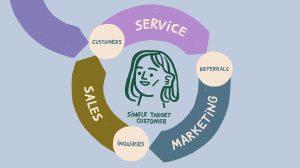Written by Amal Abdalhay
Discover the best platform for your marketing goals as we delve into the differences between publishing on LinkedIn versus Medium and how these platforms differ from posting on your website.
When it comes to deciding where to post your content, the options can be overwhelming. But think of it as choosing the right vehicle to reach your destination; Medium is like a reliable bus that takes you to a broad audience with an established readership, while LinkedIn is more like a luxury car that can drive you toward professional connections and opportunities. Your website, on the other hand, is like a customizable bike that allows you to control the journey and tailor it to your audience’s needs.
This article will explain the differences between publishing on LinkedIn versus Medium and how these platforms differ from posting on your own website to help you figure out which platform is best for your content and marketing goals.
Jump To
- Long-Form Content and Why it Works Well
- Posting on LinkedIn: Linking in or Missing out?
- Posting on Medium: The Highs and Lows of Sharing Your Thoughts Online
- Posting on Your Own Website: Freedom or Responsibility?
- Choosing Your Content’s Home
Long-Form Content and Why it Works Well
Long-form content refers to any content that provides in-depth analysis and storytelling. It usually comes in the form of blog posts or articles that are longer than 1000 words, or videos and podcasts that are longer than 20 minutes.
As an interior designer, Long-form content makes your service tangible. It gives you the space to peel back the curtains and show people your process, opinions and knowledge before hiring you.
For instance, if you specialize in retail design, you can use long-form content to explain how you take visual merchandising and trade marketing into account in your interior design process. If you specialize in restaurant design, you can discuss your approach to designing chain restaurants and creating the same brand experiences across different spaces. Similarly, a residential designer can write about their process for understanding how families live and designing kitchens that reflect their needs and lifestyle. By sharing these insights through long-form content, designers can establish their expertise and build trust with potential clients. Moreover, longer content generally ranks higher in search engine results because it’s able to deliver more valuable and trustworthy information. This results in better exposure for your brand and increased traffic to your website.
But where should you publish your content?
The truth is each publishing platform is different. The audience, the topics, and the algorithm will affect how your content is showcased. To take advantage of these differences, you must be sure of what kind of content you offer and who your audience is. Below, we outline the pros and cons of publishing content on third-party platforms versus hosting it on your website.
Posting on LinkedIn: Linking in or Missing out?
LinkedIn is a social media platform designed specifically for professionals and businesses. Users highlight their work experience, education, and skills while connecting with other industry professionals. Here’s what to expect when blogging on LinkedIn:
Pros of Publishing Content on LinkedIn
- Network building. LinkedIn is a professional social network. Posting content on the platform can help you connect with like-minded professionals and establish a network of contacts that can help you in your career or business endeavours.
- Thought leadership. Consistently creating and sharing valuable content on LinkedIn can build your reputation as a trusted authority in your field and attract a following of engaged readers. Thoughtful and insightful content can establish you as a thought leader in your field and help you build credibility.
- Cost-effective and straightforward. It’s easy to create an account and start writing; the interface is clean and intuitive. You don’t have to buy a domain, pay for hosting, or design and develop a website or brand. It’s a great way to promote your content without any financial investment.
Cons of Publishing Content on LinkedIn
- Limited creativity. LinkedIn’s platform has certain limitations when it comes to formatting and design, which can restrict your ability to create visually appealing or unique content. For instance, users are limited to a standard font and cannot use custom fonts or incorporate advanced formatting options, such as embedded videos or interactive elements.
- Content rights. When you post content on LinkedIn, you retain the rights to your content, but you grant LinkedIn a licence to use, display, and distribute it. This means that LinkedIn can display your content on their platform and use it to promote the site or its services.
- Loss of control. When you post content on a third-party platform, getting people to visit your website and look into the services you offer can be more difficult. This means you won’t fully control how people interact with your business. The platform you’re using may have rules and limitations that you have to follow, and you might also see competitors’ content or advertisements displayed on your page.
- Less data ownership. When posting on a third-party platform, you may not have complete ownership of the customer data collected through that platform. This means you might be unable to study your audience properly to find ways to improve their experience. If your customers are not satisfied, you may not have enough information to know what went wrong, and you could lose them as a customer as a result.
- Platform dependence. When you post content on LinkedIn, you become somewhat dependent on the platform. This means that if LinkedIn were to experience any technical issues or changes to its algorithm or policies, it could impact your ability to reach your audience and promote your content.
Posting on Medium: The Highs and Lows of Sharing Your Thoughts Online
Medium is an online platform that provides an opportunity for anyone to write and publish articles with long-form content and essays covering a wide range of topics. Here’s what to expect when you publish on Medium:
Pros of Publishing Content on Medium
- Easy to use. The platform is user-friendly and makes it easy to create and publish content, even if you’re not tech-savvy.
- Diverse audience. Medium has 100 million monthly readers from different industries and backgrounds, which makes it a great platform for reaching a diverse audience.
- Curation. Medium’s curators actively promote high-quality content on the platform, which can help your content gain visibility and exposure.
- Revenue opportunities. If you’re wondering if it’s profitable to write on Medium, then the answer is yes! Medium offers a Partner Program that allows writers to earn money based on the engagement and readership of their content.
Cons of Publishing Content on Medium
- Lack of control. The biggest problem when making Medium your primary blog is that you don’t own your content. If the platform decides to turn off its site, delete your articles, or ban your blog, there’s nothing you can do. They can delete everything you’ve written and the audience you’ve built.
- Limited access to data. When you publish on Medium, you may have limited access to audience data, such as email addresses, contact details, or browsing behaviour. This can make it harder to build your list and target specific audience segments with personalized content and offers.
- Medium owns your content. When you blog on Medium, you essentially grant them a license to use and distribute your content on their platform. This means you may not have as much control over how your content is used or repurposed.
- Limited branding. Medium’s platform only allows for a little branding or customization, which makes it difficult to establish a strong brand identity if you make it your primary blogging platform.
Posting on Your Own Website: Freedom or Responsibility?
If you create a blog on your website, you’ll use tools like WordPress or Squarespace to make it. The blog will be hosted on a server you own and manage, giving you complete control over how your blog looks and works, and you’ll be responsible for taking care of it. You’ll need to keep it secure, maintain it, and update it as needed. By doing this, you can create a blog that reflects your personal style or brand. Here’s what to expect when you blog on your website:
Pros of Publishing Content on Your Website
- You’re in full control. You have complete control over the presentation and distribution of your content. You can customize your website’s design, layout, and functionality to your liking.
- Data ownership and analytics. When you publish on your website, you own the data and analytics associated with your content. This can help you track your audience’s behaviour, preferences, and engagement and optimize your sales journey accordingly.
- Branding. Your website can serve as an extension of your personal or company brand, allowing you to establish a unique online presence and build brand recognition.
- SEO benefits. When you have your own domain, you have more control over the technical aspects of SEO, such as optimizing title tags, meta data, and URL structures, which can help improve your search engine rankings and drive more organic traffic to your website.
Cons of Publishing Content on Your Website
- Cost. Setting up and maintaining a website can be costly, especially if you need to hire a web developer or designer.
- Technical skills. You may need to have some technical skills or hire someone to manage your website, such as handling security, backups, and updates.
- Traffic generation. Unlike LinkedIn and Medium, you need to actively promote your website to drive traffic and build an audience, which is demanding in terms of time and finances.
- SEO know-how. You’ll be in charge of optimizing your blog for SEO, which is time-consuming and requires technical knowledge.
- Time investment. Maintaining a website requires a significant time investment, including creating content, managing comments and feedback, and analyzing data.
Choosing Your Content’s Home
Choosing the right platform to share your content is important. Consider your goals and your audience’s preferences and behaviours, and ask yourself: Do you want to reach a large audience, even if it takes time, or do you want to reach them quickly? Are the people you want to reach already on a specific platform? Do you have an email list? And how comfortable are you with technology? Answering these questions will help you choose the right platform to reach your final destination.
How to Work with Us
We help design-build firms increase website traffic by 5 times and sales inquiries by 3 times. Hire us to train you on our program, or do it all for you.
Check out the five questions to ask yourself before hiring an agency. If you think we’d make a good team, contact us today!
Amal Abdalhay
Amal Abdalhay is a content writer. With a background in journalism and design, she combines both expertise to plan and write content for all our clients at Findable Digital Marketing. On the weekends, catch Amal between coffee, pastries, family and friends. She is based in Toronto, Canada.
 A Cheat Sheet on How to Write a Service Page
A Cheat Sheet on How to Write a Service Page The Delicate Dance Between SEO and Creativity
The Delicate Dance Between SEO and Creativity The Tricky Balance Between Thought Leadership and SEO
The Tricky Balance Between Thought Leadership and SEO

